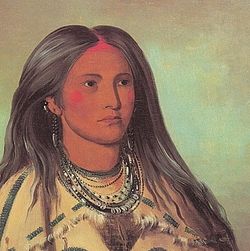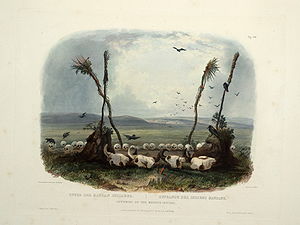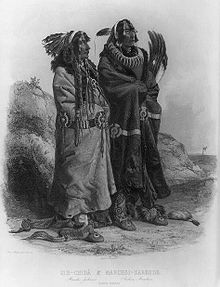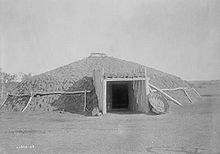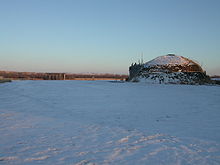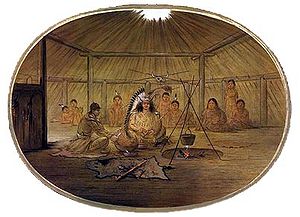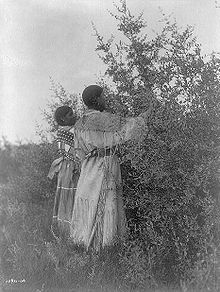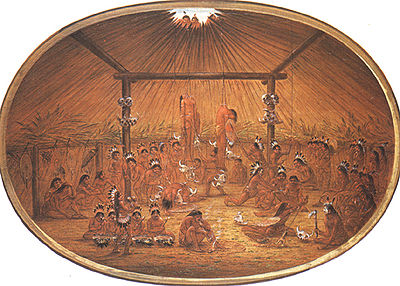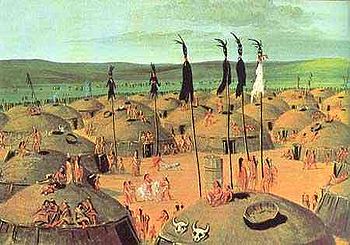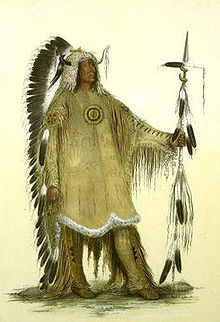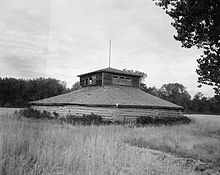- Mandan
-
Mandan Portrait of Sha-kó-ka, a Mandan girl,
by George Catlin, 1832Total population fewer than the 6,000 (1990s) enrolled
in the Three Affiliated Tribes[1]Languages Religion Mandan
Related ethnic groups The Mandan are a Native American people living in North Dakota. They are enrolled in the Three Affiliated Tribes of the Fort Berthold Reservation, North Dakota. About half of the Mandan still reside in the area of the reservation; the rest reside around the United States and in Canada.
The Mandan historically lived along the banks of the Missouri River and two of its tributaries—the Heart and Knife Rivers—in present-day North and South Dakota. Speakers of Mandan, a Siouan language, the people developed a settled culture in contrast to that of more nomadic tribes in the Great Plains region. They established permanent villages featuring large, round, earth lodges some 40 feet (12 m) in diameter, surrounding a central plaza. While the bison was key to the daily life of the Mandan, it was supplemented by agriculture and trade.
Contents
Population
The Mandan population was 3,600 in the early 18th century.[1] In 1836, there were over 1,600 fullblood Mandans, but this number was estimated to have dropped to 125 by 1838. In the 1990s, 6,000 people were enrolled in the Three Affiliated Tribes.[1]
Synonymy
The English name Mandan is derived from the French-Canadian explorer Pierre Gaultier, Sieur de la Verendrye, who heard it as Mantannes from his Assiniboine guides in 1738. He had previously heard the earth lodge peoples referred to by the Cree as Ouachipouennes, "the Sioux who go underground." The Assiniboine are Siouan speakers. Nearby Siouan speakers had exonyms similar to Mantannes in their languages, for instance, Teton Miwátąni, Yanktonai Miwátani, Yankton Mawátani or Mąwátanį, Dakota Mawátąna or Mawátadą, etc.
The Mandan have used differing autonyms to refer to themselves:
- Rųwą́ʔka·ki "men, people": before 1837 (transcribed by European Americans as Numakaki, Numangkake)
- Wį́ʔti Ų́tahąkt "East Village" (after the village of the same name): late 19th century (transcribed as Metutahanke or Mitutahankish)
- Rų́ʔeta "ourselves, our people" (originally the name of a specific division): this is the term the people now use
The Mandan probably used Rųwą́ʔka·ki to refer to a general tribal entity. Later, this word fell to disuse and instead two division's names were used, Nuweta or Ruptare (i.e., Mandan Rų́ʔeta). Later, the term Rų́ʔeta was extended to refer to a general tribal entity. The name Mi-ah´ta-nēs recorded by Ferdinand Vandeveer Hayden in 1862, reportedly means "people on the river bank", but this may be a folk etymology.
Various other terms and alternate spellings that occur in the literature including: Mayátana, Mayátani, Mąwádanį, Mąwádąδį, Huatanis, Mandani, Wahtani, Mantannes, Mantons, Mendanne, Mandanne, Mandians, Maw-dân, Meandans, les Mandals, Me-too´-ta-häk, Numakshi, Rųwą́’kši, Wíhwatann, Mevatan, Mevataneo.[2] Gloria Jahoda in Trail of Tears states that they also call themselves the "Pheasant people."[3] George Catlin states The Mandans (or See-pohs-kah-nu-mah-kah-kee, "people of the pheasants," as they call themselves)[4]
Language
The Mandan language belongs to the Siouan language family. It was initially thought to be closely related to the languages of the Hidatsa and the Crow. However, since the Mandan language has been in contact with Hidatsa and Crow for many years, the exact relationship between Mandan and other Siouan languages (including Hidatsa and Crow) has been obscured. For this reason, linguists classify Mandan most often as a separate branch of the Siouan family.
Mandan has two main dialects: Nuptare and Nuetare. Only the Nuptare variety survived into the 20th century, and all speakers were bilingual in Hidatsa. Linguist Mauricio Mixco of the University of Utah has been involved in fieldwork with remaining speakers since 1993. As of 1999, there were only six fluent speakers of Mandan still alive. As of 2010, programs in local schools encourage students' learning the language.[5]
The Mandan and their language received much attention from European Americans, in part because their lighter skin color caused speculation they were of European origin. In the 1830s, Prince Maximilian of Wied spent more time recording Mandan over all other Siouan languages and additionally prepared a comparison list of Mandan and Welsh words (he thought that the Mandan may have been displaced Welsh).[6] The theory of the Mandan/Welsh connection, now discounted, was also supported by George Catlin.
Mandan has different grammatical forms that depend on gender of the addressee. Questions asked of men must use the suffix -oʔša while the suffix -oʔrą is used when asking of women. Likewise the indicative suffix is -oʔs when addressing men and -oʔre when addressing women, and also for imperatives: -ta (male), -rą (female).[7] Mandan, like many other North American languages, has elements of sound symbolism in their vocabulary. A /s/ sound often denotes smallness/less intensity, /ʃ/ denotes medium-ness, /x/ denotes largeness/greater intensity:[8]
- síre "yellow"
- šíre "tawny"
- xíre "brown"
- sró "tinkle"
- xró "rattle"
Culture
Lodges and villages
Snow scene of a modern reconstructed earth lodge at the Knife River Indian Villages National Historic Site, North Dakota
One of the most recognizable features of the Mandan was their permanent villages made up of earthen lodges. Each lodge was circular with a dome-like roof and a square hole at the apex of the dome through which smoke could escape. The exterior was covered with a matting made from reeds and twigs and then covered with hay and earth, which protected the interior from rain, heat and cold. The lodge also featured an extended portico-type structure at the entrance.[9]
The interior was constructed around four large pillars, upon which crossbeams supported the roof. These lodges were designed, built and owned by the women of the tribe, and ownership was passed through the female line. Generally 40 feet (12 m) in diameter, they could hold several families, up to 30 or 40 people. Villages usually had around 120 lodges.[9] Reconstructions of these lodges may be seen at Fort Abraham Lincoln State Park near Mandan, North Dakota, and the Knife River Indian Villages National Historic Site.
Originally lodges were rectangular, but around 1500 CE, lodges began to be constructed in a circular form. Toward the end of the 19th century, the Mandan began constructing small log cabins, usually with two rooms. When traveling or hunting, the Mandan would use skin tipis.[10] Today, the Mandan live in modern dwellings.
Villages were usually oriented around a central plaza that was used for games(chunkey) and ceremonial purposes. In the center of the plaza was a tree surrounded by a wood enclosure. It represented the "Lone Man", one of the main figures in Mandan religion. He was said to have built a wooden corral that saved the people of a village from a flooding river in North Dakota.[11] Villages were often situated on high bluffs over the river. Often, villages would be constructed at the meeting of tributaries, to use the water as a natural barrier. Where there were few or no natural barriers, the villages utilized some type of fortification, including ditches and palisades.
Family life
The Mandan were originally divided into thirteen clans, which were reduced to four by 1950.[11] Clans organized around successful hunters and their kin. Each clan was expected to care for its own, including orphans and the elderly, from birth to death. Clans held a sacred bundle, which consisted of a few gathered objects believed to hold sacred powers. Those in possession of the bundles were considered to have sacred powers bestowed to them by the spirits and thus were considered the leaders of the clan and tribe.
Children were named ten days after their birth in a naming ceremony, which also officially linked the child with its family and clan. Girls would be taught domestic duties, farming, and how to keep a home. Boys were taught hunting and fishing, and would begin fasting for religious visions at the age of ten or eleven. Marriage among the Mandan was generally arranged by members of one's own clan, especially uncles; although, occasionally it would take place without the approval of the couple's parents. Divorce could be easily obtained.
Upon the death of a family member, the people would erect a scaffold near the village to contain the body. The body would be placed with the head towards the northwest and feet to the southeast. Southeast is the direction of the Ohio River Valley, from which the Mandan came. The Mandan would not sleep in this orientation, because it invited death. After a ceremony to send the spirit away, the family would mourn at the scaffold for four days. After the body rotted and the scaffold collapsed, the bones would be gathered up and buried, except for the skull, which was placed in a circle near the village. Family members would visit the skulls and talk to them, sometimes bearing their problems or regaling the dead with jokes. After the Mandan moved onto the Fort Berthold Reservation, they resorted to placing the bodies in boxes or trunks, or wrapped them in fur robes and placed them in rocky crevices.
Subsistence
The Mandan survived by hunting, farming and gathering wild plants, though some food came from trade. Mandan gardens were often located near river banks, where annual flooding would leave the most fertile soil, sometimes in locations miles from villages. Women owned and tended the gardens, where they planted several varieties of corn, beans and squash. The crops were planned to be sufficient to last a single year.
Hunting the buffalo was a critical part of Mandan survival and rituals. They called the buffalo to “come to the village” in the Buffalo Dance ceremony at the beginning of each summer. In addition to eating the meat, the Mandan used all parts of the buffalo, so nothing went to waste. The hides were used for buffalo-fur robes or were tanned, and the leather used for clothing, bags, shelter and other uses. The Mandan were known for their painted buffalo hides that often recorded historic events. The bones would be carved into items such as needles and fish hooks. Bones were also used in farming: for instance, the scapula was used as a hoe-like device for breaking the soil. Besides buffalo, the Mandan trapped small mammals for food and hunted deer. Deer antlers were used to create rake-like implements used in farming. Birds were hunted for meat and feathers, the latter used for adornment.
Dress
Up until the late 19th century, when Mandan people began adopting Western-style dress, they commonly wore clothing made from the hides of buffalo, as well as deer and sheep. From the hides, tunics, dresses, buffalo-fur robes, moccasins, gloves, loincloths and leggings could be made. These items were often ornamented with quills and bird feathers, and men sometimes wore the scalps of enemies.
Mandan women wore ankle-length dresses made of deerskin or sheepskin. This would often be girded at the waist with a wide belt. Sometimes the hem of the dress would be ornamented with pieces of buffalo hoof. Underneath the dress, they wore leather leggings with ankle-high moccasins. Women's hair was worn straight down in braids.
During the winter months, men would commonly wear deerskin tunics and leggings with moccasins. They also kept themselves warm by wearing a robe of buffalo fur. During the summer months, however, a loincloth of deerskin or sheepskin would often suffice. Unlike the women, men would wear various ornaments in their hair. The hair was parted across the top with three sections hanging down in front. Sometimes the hair would hang down the nose and would be curled upwards with a curling stick. The hair would hang to the shoulders on the side, and the back portion would sometimes reach to the waist. The long hair in the back would create a tail-like feature, as it would be gathered into braids then smeared with clay and spruce gum then tied with cords of deerskin. Headdresses of feathers were often worn as well.[12] Besides buffalo, elk, and deer hides, Mandans also used ermine and white weasel hides for clothing.[13]
Today, Mandan people wear traditionally-inspired clothing and regalia at powwows, ceremonies, and other significant events.
Religion
The Mandan's religion and cosmology was highly complex and centered around the figure known as Lone Man. Lone Man was involved in many of the creation myths as well as one of the deluge myths.
In their creation myth, the world was created by two rival deities, the First Creator and the Lone Man. The Missouri River divided the two worlds that the beings created. First Creator created the lands to the south of the river with hills, valleys, trees, buffalo, pronghorn antelope and snakes. To the north of the river, Lone Man created the Great Plains, domesticated animals, birds, fish and humans. The first humans lived underground near a large lake. Some of the more adventurous humans climbed a grapevine to the surface and discovered the two worlds. After returning underground, they shared their findings and decided to return with many others. As they were climbing the grapevine, it broke and half the Mandan were left underground.[14]
According to pre-Christian Mandan beliefs, each person possessed four different, immortal souls. The first soul was white and often seen as a shooting star or meteor. The second soul was colored a light brown and was seen in the form of the meadowlark. The third soul, called the lodge spirit, remained at the site of the lodge after death and would remain there forever. The final soul was black and after death would travel away from the village. These final souls existed as did living people; residing in their own villages, farming and hunting.[10]
The Okipa ceremony was a major part of Mandan religious life. This complex ceremony about the creation of the earth was first recorded by George Catlin. The ceremony opened with a Bison Dance, followed by a variety of torturous ordeals through which warriors proved their physical courage and gained the approval of the spirits. The Okipa began with the young man not eating, drinking, or sleeping for four days. Then they were led to a hut, where they had to sit with smiling faces while the skin of their chest and shoulders was slit and wooden skewers were thrust behind the muscles. Using the skewers to support the weight of their bodies, the warriors would be suspended from the roof of the lodge and would hang there until they fainted. To add agony, heavy weights were added to the initiate's legs. After fainting, the warrior would be pulled down and the men (women were not allowed to attend this ceremony) would watch the warrior until he awoke, proving the spirits' approval. Upon awakening, the warrior would offer his left pinkie finger to the Great Spirit, whereupon a masked tribesman would sever it with a hatchet blow. Finally, participants would endure a grueling race around the village called "the last race" with weights and skewers still in place, to determine who among them was the strongest.
Those finishing the ceremony were seen as being honored by the spirits; those completing the ceremony twice would gain everlasting fame among the tribe. Chief Four Bears, or Ma-to-toh-pe, completed this ceremony twice.[15] The last Okipa ceremony was performed in 1889, but the ceremony was resurrected in a somewhat different form in 1983.[14] The version of the Okipa as practiced by the Lakota may be seen in the 1970 film A Man Called Horse starring Richard Harris.
History
Origins and early history
The exact origins and early history of the Mandan is unknown. Early studies by linguists gave evidence that the Mandan language may have been closely related to the language of the Ho-Chunk or Winnebago people of present-day Wisconsin. Scholars theorize they may have settled in the Wisconsin area at one time. This idea is possibly confirmed in their oral history, which refers to their having come from an eastern location near a lake.
Ethnologists and scholars studying the Mandan subscribe to the theory that, like other Siouan-speaking people (possibly including the Hidatsa), they originated in the area of the mid-Mississippi River and the Ohio River valleys in present-day Ohio. If this was the case, the Mandan would have migrated north towards the Missouri River Valley and its tributary the Heart River in present-day North Dakota. That is where Europeans first encountered the historical tribe. This migration is believed to have occurred possibly as early as the 7th century but probably between 1000 CE and the 13th century, after the cultivation of maize was adopted.[16]
After their arrival on the banks of the Heart River, the Mandan constructed nine villages, two on the east side of the river and seven on the west side. At some point during this time, the Hidatsa people also moved into the region. Mandan tradition states that the Hidatsa were a nomadic tribe until their encounter with the Mandan, who taught them to build stationary villages and cultivate agriculture. The Hidatsa continued to maintain amicable relations with the Mandan and constructed villages north of them on the Knife River.
European encounter
The first encounter with Europeans occurred with the visit of the French Canadian trader Sieur de la Verendrye in 1738. It is estimated that at the time of his visit, 15,000 Mandan resided in the nine villages on the Heart River.[17] Horses were acquired by the Mandan in the mid-18th century from the Apache and were used for transportation and hunting. The horses helped with the expansion of Mandan hunting territory on to the Plains. The encounter with the French in the 18th century created a trading link between the French and Native Americans of the region; the Mandan served as middlemen in the trade in furs, horses, guns, crops and buffalo products. Spanish merchants and officials in St. Louis explored the Missouri and strengthened relations with the Mandan (whom they called Mandanas) in an effort to discourage trade in the region by the English and the Americans. The Spanish sought to establish direct overland communication between Santa Fé and St. Louis.
In 1796 the Mandan were visited by the Welsh explorer John Evans, who was hoping to find proof that their language contained Welsh words. Evans had arrived in St. Louis 2 years prior, and after being imprisoned for a year, was hired by Spanish authorities to lead an expedition to chart the upper Missouri. Evans spent the winter of 1796–97 with the Mandan but found no evidence of any Welsh influence. In July 1797 he wrote to Dr. Samuel Jones, "Thus having explored and charted the Missurie for 1,800 miles and by my Communications with the Indians this side of the Pacific Ocean from 35 to 49 degrees of Latitude, I am able to inform you that there is no such People as the Welsh Indians.".[18]
By 1804 when Lewis and Clark visited the tribe, the number of Mandan had been greatly reduced by smallpox epidemics and warring bands of Assiniboine, Lakota and Arikara. (Later they joined with the Arikara in defense against the Lakota.) The nine villages consolidated into two villages. The Lewis and Clark expedition met with such hospitality in the Upper Missouri River villages that the expedition stopped there for the winter. In honor of their hosts, the expedition dubbed the settlement they constructed Fort Mandan. It was here that Lewis and Clark first met Sacagawea, a Shoshone woman who had been captured by the Hidatsa. Sacagawea assisted the expedition with information and translating skills as they travelled westward towards the Pacific Ocean. Upon their return to the Mandan villages, Lewis and Clark took the Mandan Chief Sheheke (Coyote or Big White) with them to Washington to meet with President Thomas Jefferson. In 1812 Chief Sheheke was killed in a battle with Hidatsa.[19]
In 1833, artist George Catlin visited the Mandan near Fort Clark. Catlin painted and drew scenes of Mandan life as well as portraits of chiefs, including Four Bears or Ma-to-toh-pe. His skill at rendering so impressed Four Bears that he invited Catlin as the first man of European descent to be allowed to watch the Okipa ceremony. The winter months of 1833 and 1834 brought Prince Maximilian of Wied-Neuwied and Swiss artist Karl Bodmer to stay with the Mandan.
Speculation about pre-Columbian European contact
18th-century reports about characteristics of Mandan lodges, religion and occasional physical features among tribal members, such as blue and grey eyes along with lighter hair coloring, stirred speculation about the possibility of pre-Columbian European contact. Catlin believed the Mandan were the "Welsh Indians" of folklore, descendants of Prince Madoc and his followers who emigrated to America from Wales in about 1170. This view was popular at the time but has since been disputed by the bulk of scholarship.[20]
Later speculation has suggested the Mandan may have had pre-Columbian contact with Viking explorers. Controversial interpretations of the Kensington Runestone, found in 1898 in the largely rural township of Solem, Douglas County, Minnesota, have cited the runestone as evidence of Viking presence. There is no known evidence of Mandan-Viking contact, however. This theory is not supported generally by scholars such as anthropologists and professional historians.[21]
Smallpox epidemic of 1837–38
The Mandan were first plagued by smallpox in the 16th century and had been hit by similar epidemics every few decades. Between 1837 and 1838, another smallpox epidemic swept the region. In June 1837, an American Fur Company steamboat traveled westward up the Missouri River from St. Louis. Its passengers and traders aboard infected the Mandan, Hidatsa and Arikara tribes. There were approximately 1,600 Mandan living in the two villages at that time. The disease effectively destroyed the Mandan settlements. Almost all the tribal members, including the chief, Four Bears, died. Estimates of the number of survivors vary from only 27 individuals to up to 150, though most sources usually give the number 125. The survivors banded together with the nearby Hidatsa in 1845 and created Like-a-Fishhook Village.
Mandan chief Four Bears reportedly stated “a set of Black harted [sic] Dogs, they have deceived Me, them that I always considered as Brothers, has turned Out to be My Worst enemies”.[22] Francis Chardon, in his "Journal at Fort Clark 1834–1839", wrote that the Gros Ventres (ie. Hidatsa), “swear vengeance against all the Whites, as they say the small pox was brought here by the S[team] B[oat].” (Chardon, Journal, p. 126). In the earliest detailed study of the event, in The American Fur Trade of the Far West (1902), Hiram M. Chittenden blamed the American Fur Company for the epidemic. Oral tradition of the affected tribes continue to claim that whites were to blame for the disease.[23] R. G. Robertson in his book Rotting Face: Smallpox and the American Indian places blame on Captain Pratte of St. Peter’s for failing to quarantine once the epidemic broke out, stating that while “not guilty of premeditated genocide, but he was guilty of contributing to the deaths of thousands of innocent people. The law calls his offence criminal negligence. Yet in light of all the deaths, the almost complete annihilation of the Mandans, and the terrible suffering the region endured, the label criminal negligence is benign, hardly befitting an action that had such horrendous consequences”.[24]
Ward Churchill has alleged that the US Army gave smallpox infected blankets to the Mandan Indians in 1837, as part of a genocidal conspiracy. No historian specializing in that event has agreed with Churchill's accusations against the Army. A University of Colorado investigation into Churchill's research found that in this instance he had misrepresented his sources and "created myths under the banner of academic scholarship."[25][26]
Late 19th and the 20th centuries
The Mandan joined with the Arikara in 1862. By this time, Like-a-Fishhook Village had become a major center of trade in the region. By the 1880s, though, the village was abandoned. With the second half of the 19th century there was a gradual decrease in the holdings of the Three Affiliated Tribes (the Mandan, Hidatsa and Arikara). The Fort Laramie Treaty of 1851 recognized 12 million acres (49,000 km²) of land in the territory owned jointly by these tribes. With the creation of the Fort Berthold Reservation by Executive Order on April 12, 1870, the federal government recognized the holdings as only being 8 million acres (32,000 km²). On July 1, 1880, another executive order deprived the tribes of 7 million acres (28,000 km²) lying outside the boundaries of the reservation.
With the arrival of the 20th century, the government seized more land, and by 1910, the reservation had shrunk to a mere 900,000 acres (3,600 km²).[27] This land is located in Dunn, McKenzie, McLean, Mercer, Mountrail and Ward counties in North Dakota.
With the 1934 Indian Reorganization Act, the Mandan officially merged with the Hidatsa and the Arikara into the Three Affiliated Tribes, known as the Mandan, Hidatsa and Arikara Nation.
In 1951, the U.S. Army Corps of Engineers began construction of Garrison Dam on the Missouri River. This dam created Lake Sakakawea, which flooded portions of the Fort Berthold Reservation including the villages of Fort Berthold and Elbowoods as well as a number of other villages. The former residents of these villages were moved and New Town was established for them.
While a new town was constructed for the displaced tribal members, much damage was done to the social and economic foundations of the reservation. The flooding claimed approximately one quarter of the reservations land. This land contained some of the most fertile agricultural land upon which the agricultural economy had been constructed. In addition, the flooding claimed the sites of historic villages and archaeological sites.
Present day
The Mandan and the two related tribes, the Hidatsa and Arikira, while being combined have intermarried but do maintain, as a whole, the varied traditions of their ancestors. The last full-blood Mandan, Mattie Grinnell, died in 1971.[14] The tribal residents have recovered from the trauma of their displacement in the 1950s and part of their recovery has been aided by two recent additions to New Town. The Four Bears Casino and Lodge was constructed in 1993 drawing tourists and money to the impoverished reservation.[28] The most recent addition to the New Town area has been the new Four Bears Bridge, which was built in a joint effort between the three tribes and the North Dakota Department of Transportation. The bridge, spanning the Missouri River, replaces an older Four Bears Bridge that was built in 1955. The new bridge—the largest bridge in the state of North Dakota—is decorated with medallions celebrating the cultures of the three tribes. The bridge was opened to traffic September 2, 2005, and was officially opened in a ceremony on the October 3.[29]
See Also
- White Buffalo Cow Society
Notes
- ^ a b c Pritzker 335
- ^ Synonymy section written by D. R. Parks in Wood & Irwin, pp. 362–364.
- ^ Jahoda p. 174.
- ^ Catlin p.80 vol.1 North American Indians.
- ^ Personal communication from Mauricio Mixco in 1999, reported in Parks & Rankin p. 112.
- ^ Chafe pp. 37–38.
- ^ Hollow 1970, p. 457 (in Mithun p. 280).
- ^ Hollow & Parks 1980, p. 82.
- ^ a b Pritzker p. 336.
- ^ a b Zimmerman pp. 298–299.
- ^ a b Bowers 161–162
- ^ Zimmerman pp. 299–300.
- ^ Pritzker 337
- ^ a b c "Mandan Creation Myth." Native Languages. (retrieved 24 Aug 2011)
- ^ Jahoda pp. 177–182.
- ^ Hodge, p. 796.
- ^ "Mandan", The Catholic Encyclopedia.
- ^ Williams, Gwen A., Madoc, the Making of a Myth, Eyre Methuen, 1979
- ^ Potter 178
- ^ Newman 255–272
- ^ Viking settlement and the Mandans
- ^ Smithsonian Magazine | Science & Nature | Tribal Fever
- ^ "Report of the Investigative Committee of the Standing Committee on Research Misconduct at the University of Colorado at Boulder concerning Allegations of Academic Misconduct against Professor Ward Churchill" (PDF). May 9, 2006. http://www.colorado.edu/news/reports/churchill/download/WardChurchillReport.pdf. Retrieved 2008-03-26.
- ^ Robertson, Rotting Face, pp. 299–303.
- ^ Brown, Thomas (2006). "Did the U.S. Army Distribute Smallpox Blankets to Indians? Fabrication and Falsification in Ward Churchill’s Genocide Rhetoric" (PDF). Plagiary: Cross-Disciplinary Studies in Plagiarism, Fabrication, and Falsification 1 (9). http://www.plagiary.org/smallpox-blankets.pdf
- ^ Wesson, Marianne; Clinton, Robert; Limón, José; McIntosh, Marjorie; Radelet, Michael (May 9 2006) (PDF). Report of the Investigative Committee of the Standing Committee on Research Misconduct at the University of Colorado at Boulder concerning Allegations of Academic Misconduct against Professor Ward Churchill. University of Colorado at Boulder. http://www.colorado.edu/news/reports/churchill/download/WardChurchillReport.pdf
- ^ Pritzker p. 335.
- ^ Indian Gaming Association press release For casino opening date.
- ^ Kvamme, Thomas A (2005-09-02). "New Four Bears Bridge is open for traffic". Williston Herald. http://www.willistonherald.com/articles/2005/09/02/news/news4.txt.
References
- Bowers, Alfred W. (1950 reprinted 2004). Mandan Social and Ceremonial Organisation. Bison Books. ISBN 978-0-8032-6224-9.
- Chafe, Wallace. (1976). The Caddoan, Iroquoian, and Siouan languages. Trends in linguistics: State-of-the-art report (No. 3). The Hague: Mouton. ISBN 90-279-3443-6.
- Jahoda, Gloria. Trail of Tears: The Story of the American Indian Removals, 1813–1835. New York: Wings Books, 1975. ISBN 0-517-14677-0.
- Hollow, Robert C. (1970). A Mandan dictionary. (Doctoral dissertation, University of California, Berkeley).
- Hollow, Robert C. and Douglas Parks (1980). Studies in plains linguistics: A review. In W. R. Wood & M. P. Liberty (Eds.), Anthropology on the Great Plains (pp. 68–97). Lincoln: University of Nebraska. ISBN 0-8032-4708-7.
- Newman, Marshall T. "The Blond Mandan: A Critical Review of an Old Problem." Southwestern Journal of Anthropology. Vol. 6, No. 3 (Autumn, 1950): 255–272.
- Parks, Douglas R.; & Rankin, Robert L. (2001). The Siouan languages. In R. J. DeMallie (Ed.), Handbook of North American Indians: Plains (Vol. 13, Part 1, pp. 94–114). W. C. Sturtevant (Gen. Ed.). Washington, D.C.: Smithsonian Institution. ISBN 0-16-050400-7.
- Potter, Tracy A., Sheheke: Mandan Indian Diplomat, The Story of White Coyote, Thomas Jefferson, and Lewis and Clark. Helena, MT: Farcountry Press and Fort Mandan Press, 2003. ISBN 1-56037-255-9.
- Pritzker, Barry M. A Native American Encyclopedia: History, Culture, and Peoples. Oxford: Oxford University Press, 2000. ISBN 978-0195138771.
- Robertson, R. G. (2001). Rotting Face. Caldwell, ID: Caxton Press. ISBN 0870044192.
- Williams, Gwen A., Madoc, the Making of a Myth, Eyre Methuen, 1979.
- Zimmerman, Karen. "Mandan". In The Gale Encyclopedia of Native American Tribes, Vol. III. Detroit: Gale, 1998. ISBN 0-7876-1088-7.
Further reading
- Hayden, Ferdinand Vandeveer. (1862). Contributions to the ethnography and philology of the Indian tribes of the Missouri Valley: Prepared under the direction of Capt. William F. Reynolds, T.E.U.S.A., and published by permission of the War Department. Transactions of the American Philosophical Society, 12 (2), 231–461. Philadelphia: C. Sherman and Son.
- Hodge, Frederick Webb, Ed. Handbook of American Indians North of Mexico. Originally published by the Bureau of American Ethnology and the Smithsonian Institution in 1906. (Reprinted in New York: Rowman and Littlefield, 1971. ISBN 1-58218-748-7)
- Wolff, Gerald W., and Cash, Joseph, H. (1974), Three Affiliated Tribes, a study of the cultural relationships among the Arikaras, Hidatsas, and Mandans.
- Wood, W. Raymond, & Lee Irwin. "Mandan". In R. J. DeMallie (Ed.), Handbook of North American Indians: Plains (Vol. 13, Part 1, pp. 94–114). W. C. Sturtevant (Gen. Ed.). Washington, D.C.: Smithsonian Institution, 2001. ISBN 0-16-050400-7
Language
- Kennard, Edward. (1936). Mandan grammar. International Journal of American Linguistics, 9, 1–43.
- Lowie, Robert H. (1913). Societies of the Hidatsa and Mandan Indians. In R. H. Lowie, Societies of the Crow, Hidatsa, and Mandan Indians (pp. 219–358). Anthropological papers of the American Museum Of Natural History (Vol. 11, Part 3). New York: The Trustees. (Texts are on pp. 355–358).
- Mithun, Marianne. (1999). The languages of Native North America. Cambridge: Cambridge University Press. ISBN 0-521-23228-7 (hbk); ISBN 0-521-29875-X.
- Mixco, Mauricio C. (1997). Mandan. Languages of the world series: Materials 159. Münich: LINCOM Europa. ISBN 3-89586-213-4.
- Parks, Douglas R.; Jones, A. Wesley; Hollow, Robert C; & Ripley, David J. (1978). Earth lodge tales from the upper Missouri. Bismarck, ND: Mary College.
- Will, George; & Spinden, H. J. (1906). The Mandans: A study of their culture, archaeology and language. Papers of the Peabody Museum of American Archaeology and Ethnology, Harvard University (Vol. 3, No. 4, pp. 81–219). Cambridge, MA: The Museum. (Reprinted 1976, New York: Kraus Reprint Corporation).
External links
- Mandan, Hidatsa, Arikara: Three Affiliated Tribes, official website
- Article on bridge opening from the Williston (North Dakota) Herald (Accessed November 5, 2005)
- Knife River Indian Villages National Historic Site
- Lewis and Clark Fort Mandan Foundation
- Lewis and Clark's Journals recording their time with the Mandan
- Mandan Indians, PBS
Categories:- Native American tribes in North Dakota
- Native American tribes in South Dakota
- Plains tribes
Wikimedia Foundation. 2010.

